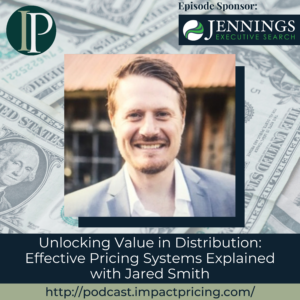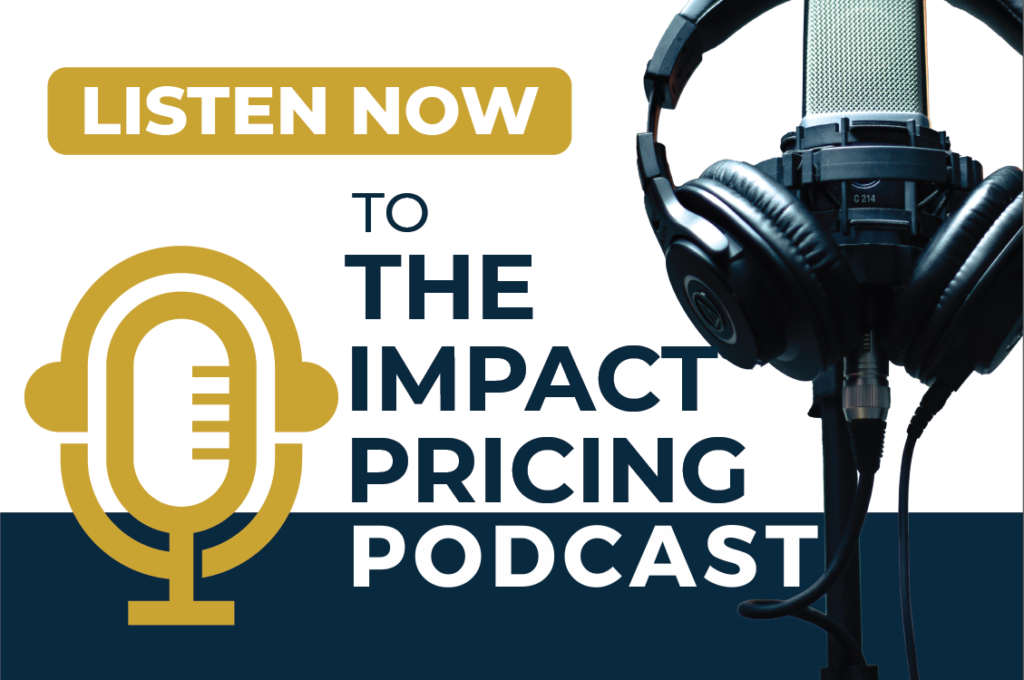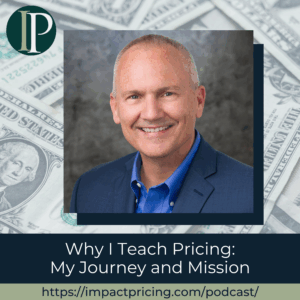Jared Smith is the CEO of PriceSmith, a consulting firm specializing in pricing strategies for distributors and light manufacturers. With a background in pricing systems from Vendavo and experience as an adjunct professor at Oklahoma State, Jared brings a wealth of knowledge to the table. He is passionate about helping companies optimize their pricing strategies to capture more value.
In this episode, Jared shares his journey from Frito-Lay to leading pricing innovation in the B2B distribution space. Together, they explore the key distinctions between B2B and B2C pricing models, especially the negotiation-heavy and data-rich nature of distribution.
Podcast: Play in new window | Download
Why you have to check out today’s podcast:
- Learn about the differences between B2B and B2C pricing strategies.
- Understand the role of pricing systems in managing large SKU portfolios in distributorship.
- Discover how to effectively segment customers for better pricing strategies.
“Invest in your master data and keep chipping away at it. Start with 80/20 of your products and get that right.”
– Jared Smith
Topics Covered:
01:42 – Jared shares how he got into pricing after his MBA and experiences at Frito-Lay and in B2B distribution.
02:57 – Discussion on the differences between B2C and B2B pricing, including transparency and data access.
06:06 – Challenges in understanding why customers buy and the limitations of data analytics.
12:55 – Jared explains his focus on distribution and the unique challenges it presents.
14:40 – Discussion on the relevance and limitations of cost-plus pricing in distribution.
19:17 – Exploration of how to implement good, better, best pricing in distribution.
25:28 – Discussion on whether distributors publish prices or rely on quotes for transactions.
26:33 – Jared shares insights from Uber experiences and how they relate to distribution pricing.
31:27 – The impact of customer loyalty on pricing strategies and potential risks.
32:55 – Jared’s key piece of advice on investing in master data for better pricing strategies.
33:58 – Connect with Jared.
Key Takeaways:
“Distribution is an amazing thing. Obviously, it’s worldwide. And the simple fact of it, it has two very unique aspects. The first one, a lot of SKUs. And then, the second one is that you have a lot of customers.” – Jared Smith
People/Resources Mentioned:
- PriceSmith: https://www.pricesmith.com/
- Vendavo: https://www.vendavo.com/
- Oklahoma State University: https://www.okstate.edu/
- Pepsi: https://www.pepsi.com/
- Frito-Lay: https://www.fritolay.com/
- Coca-Cola: https://www.coca-cola.com/
- Apple: https://www.apple.com/
- LG: https://www.lg.com/
- Uber: https://www.uber.com/
- Lyft: https://www.lyft.com/
Connect with Jared Smith:
- LinkedIn: https://www.linkedin.com/in/jaredpaulsmith/
- Email: [email protected]
Connect with Mark Stiving:
- LinkedIn: https://www.linkedin.com/in/stiving/
- Email: [email protected]
Full Interview Transcript
(Note: This transcript was created with an AI transcription service. Please forgive any transcription or grammatical errors. We probably sounded better in real life.)
Jared Smith:
Invest in your master data and keep chipping away at it. Too many people think that it needs to be this very one and done. And I’m going to just throw this silver bullet out there and I’m going to fix all my master data. When you really understand it’s an iterative process, start with 80-20 of your products and get that right. And just keep chipping away at it over time.
[Intro / Ad]
Mark Stiving:
Welcome to Impact Pricing, the podcast where we discuss pricing, value, and the dynamic relationship between them.
I’m Mark Stiving, and I run boot camps to help companies get paid more. Our guest today is Jared Smith. Here are three things you’ll learn about Jared before we start. He is the CEO of PriceSmith. We’re going to learn more about that in a minute. He’s an adjunct professor at Oklahoma State nowadays, and he did a stint at Vendavo, which means we’re probably going to talk about pricing systems today. Welcome, Jared.
Jared Smith:
Hey, thanks for having me again, Mark. Good to see you.
Mark Stiving:
My pleasure. Remind us all, how’d you get into pricing in the first place?
Jared Smith:
You know, way back in the day, after I got my MBA, I went to work for one of the Academy companies. I went to work for Pepsi, actually Frito-Lay North America. And I find myself in a group there called Growth Ventures.
It was kind of like a business within a business. And, you know, and at that point I was managing a whole P and L about 600 and 650 million and pricing came onto the plate. It was just part of the job.
And, you know, I, I like to think I had some data chops back then, you know, way back in the day, and I remember someone telling me, he’s like, hey, you know what, you should be in pricing. And I was like, I don’t even know what pricing is, right? As with most things, Mark, you just fall into it, right? And so after I left Frito-Lay, then I went to work for a building distributor as part of a transformation team in a private equity business.
We focused on pricing, and going from B2C to B2B was an absolute shock. There’s no relationship sometimes between it, but I think that really just started the whole thing around, hey, I’m learning about pricing, I went to go study it in school, and that’s just kind of how it all started out. As with everybody, you just kind of find yourself in it and keep on doing it because there’s such a love for it.
Mark Stiving:
So what did you see as the big differences between B2C and B2B?
Jared Smith:
Oh man, I think smoke and mirrors. I’ll put it as smoke and mirrors. In B2B, you just have so much variant pricing. You’re making a lot of deals. Like pricing isn’t nearly as transparent. You can’t see what your competitors are doing out there.
And you know, when I say the smoke and mirrors piece, it’s like, sometimes you’ll make deals and I, we call it the Kettleman distribution. Sometimes the good old boy deals, right? It could be a small customer and that small customer is getting as good a deals as some of your bigger customers are, you know, cause you’re just trying to win the business in these regional places.
On the B2C side, you have so much more access to data. You can calculate, you know, however you look at it, you can calculate elasticities. You can look at, you know, pastors, you can look at different things like that. understand cross selling activities and whatnot.
And in B2B, I just don’t think you have it, which makes it really kind of exciting. And one of the things that really drew me to the B2B space a little bit more.
Mark Stiving:
Yeah, it’s kind of interesting because in B2B, I agree with you completely. We do a lot of negotiations. We’ve got a direct sales team. We’re all trying to figure out how much value are we delivering to each individual customer and figuring out the price for that customer.
And it’s hard to do data analytics on that whole set.
Where in B2C, you know, you walk into Kroger’s and you buy a bag of chips, you know, it was a take it or leave it. Are you buying the chips or not buying the chips? And how many people bought chips? And what happened when we raised the price 10 cents?
So there’s tons of data for us to play with, but I’m gonna take a step back and we had a little talk just before we hit record. And it seems to me that you’re on the B2B side of the business that actually has access to data. And that’s the companies with tons of SKUs, tons of transactions, almost like a B2C kind of business.
Jared Smith:
Yeah, I think that many of the companies that I work with, and you’re right, I love working with companies that have lots of SKUs, lots of transactions.
One, you can do data science around it, but it really kind of allows you to express the art of how you segment your customers and how you architect. A lot of times the architectures that you do, around customers, you know, you could architect it by industry types, who am I selling it to, by the size of the customers.
And these are really basic ones because it’s usually present in your data. However, you can get much more sexy with your segmentation if you try to get to more of the psychology of buying habits and things like that, which, you know, kind of almost brings you almost into a true marketing mindset and how you actually go to these different segments.
But the simple fact that you have access to all these data and you can do the things like optimization, which in reality to me at the very end of the day is really nothing more than calculating a proxy for willingness to pay within your own data. And I think it’s a pretty amazing thing. It’s still very difficult though, right? Just simply because of the sheer number of SKUs that you have.
Mark Stiving:
So let me ask, I spend a lot of time thinking about the underlying concepts, the buyer behavior, why does someone choose this, how much value are they getting?
But if I were looking at a huge data set and I had tons of information, how do you get to why did they buy that? Because it feels to me like the only thing you can use is I’ve got the data that I’ve got, I don’t have the underlying reasoning.
Jared Smith:
It really is a weakness around it. That’s why I always say sort of on the, you know, the data science, the optimization piece, you’re just proxying for a willingness to pay and coming to a point estimate of what that is or a range estimate of what it is.
But to your point, this is kind of like, it brings me back to a lot of the concepts around elasticity. Elasticity says that, hey, you know, as price moves, demand moves, right? Just kind of economics 101.
But in the B2B space, there’s so many different reasons why people buy. Think about relationships, you know, think about, you know, how you present things, you know, you can get obviously into marketing and, and things like that.
But I think that there are a lot of underlying things and that’s why you always have to have a really good connection with the sales force and distribution and like light manufacturing and whatnot. If you don’t understand how those two things are playing together, then I think you just really miss a big, big opportunity because they’ll kind of go off on their own and exact different procedures and processes and sales things that are kind of independent of that that affect your data and how you analyze it.
So lots of underlying things that go along with it that you can run blind to if you’re up in the ivory tower of pricing.
Mark Stiving:
Yeah, so just to amplify what you said,think about B2C for a second. Coke advertises a lot. And theoretically, if they stopped advertising, sales would drop, and that has nothing to do with pricing, right? It just has to do with how much are we advertising.
So if we take that in the B2B world, I think a ton about, well, how are we communicating our value to our customers? And if we haven’t gotten sales people trained to truly communicate value, then we can’t capture the prices.
And so I think those prices are just, you know, there’s dynamics, not the right word, but I usually use the phrase context-driven pricing.
So how well have I explained my value? What’s the situation this buyer is in today’s situation? And so all of that would drive.
Jared Smith:
I think that you’re, you’re right on to something, you know, went there. And I think that in a lot of distribution places, especially where things are, and I hate to use this word, right. You’ve seen it in your, in your shows many times commoditized, right.
And I kind of like use it as an overgeneralization for, it’s a very competitive situation, right?
There’s a lot of people offering a lot of different things. And one of the key things I often ask the clients I work with, it is like, what makes you different?
And like a hundred percent of a hundred times we have better service. Right. And I’m like, do you, do you really, you know, what’s your delivery times, what’s your on service pieces and things like that.
And you know what I think at the very end of the day that a lot of times in the, a lot of these industries, and depending on where you’re at distribution, you can be in a really competitive piece where you’re, you know, you’re benchmarking a lot and trying to explain your value, I think is something that a lot, you know, a lot of companies don’t do. I worked with one CEO one time and, you know, one of the things he said, he goes, yeah, our value comes from our portfolio.
You know, that we have this breadth of portfolio. We have a hundred thousand SKUs that we can offer so we can be a one-stop shop. And my question back to them was. So that allows you to charge higher prices just because you have, you know, more breadth.
And I don’t, I was like, I don’t know if I really believe that. I don’t know if I, if I’m someone, I don’t know if I really care that I can just, you know, get one invoice from you.
Is that really value? And I think that, you know, finding that in distribution spaces can be a little bit tough.
Mark Stiving:
Yeah, yeah. So I think the service thing is a really good one if you can prove it, right?
If it’s real. Because if you think about the fact that, you know, it depends on what we’re distributing, but let’s assume I’m building a house and I’ve got a distributor who’s willing to deliver my materials to my facility on the day that I need them, right? This is awesome service. How much more do you want for that? Right? I’ll pay for that service.
But are you really delivering something of value. And I define value as the result of solving problems. So the question is, what problem are you solving for me?
Jared Smith:
Yeah, I think that’s some, you know, the service piece of it and getting stuff there. Right. I do think that there is something about that, to your point, if it is true.
And the thing that often happens, though, for a lot of companies, especially with cash flow and whatnot, is that the service can be very frequent, which increases your cost to serve, which probably should increase your price if you’re trying to get there.
On the other side of it, I’ve worked with building distributors, or the ones that do light manufacturing for siding for different warehouses and whatnot.
And I think that they offer really interesting value because they come in and they help you architect it, they help you design it, they help you understand what are you really trying to do.
It’s almost very project-based. even though they still manufacture and distribute. And I think that’s a very, very different thing.
So I think that I’ve seen a lot of different paradigms to help add value. A great one that I saw one time was where a company basically, they would look at other, you know, talk about a big distributor that served, you know, the entire United States.
And when they’re working with some people down there in Florida, they would do analytics to see what are your kind of like, like businesses, like you selling.
And so you can understand what you should stock yourselves with. And then we can kind of help you and understand that, you know, merchandise for you and whatnot.
That’s a real value add, right? That goes beyond me just delivering a pallet to a warehouse.
Mark Stiving:
Yep. Absolutely. And so we’re back to that issue that says, are you solving a real problem for your customers? Right. And if you are, you can charge more money for it. If your customer believes it, knows it, values it. So absolutely. Hey, I promised you we were going to talk about pricing systems and we haven’t mentioned them yet.
Let’s talk about pricing systems.
Jared Smith:
It’s okay. Yeah. No worries. No worries. Yeah. Pricing systems. I love them.
You know, the unique perspective that I have is that I was a customer of one when I first worked for, you know, the building distributor and got very intimate with it, with that. And then I worked for, uh, one, uh, you know, great company, Vendavo, who still holds a dear place in my heart. You know, after a certain amount of time, I decided that, Hey, you know what, I, there’s some things that I really want to do. I want to democratize pricing. I want to make it a little bit more accessible to the masses.
And so I started building my own and, and we’re kind of at this point right now where obviously the tariffs are in play and. Everybody needs help. And it’s kind of a, every time that these type of events hit, be it COVID or what happened in like the 2017 tariffs and what’s happening right now.
Everybody wants to get some more capabilities because they just get crushed under the weight of what’s going on.
Mark Stiving:
So back when I had a real job, I looked at a couple of pricing systems. We implemented a pricing system.
But here was the thing that I came up with or the realization I had. And that is that everybody says they can do everything, but it feels like every pricing system is truly good at one industry, one specific space. And so you can’t do everything, right?
And so now I’m going to put you on the spot. What’s your space? What is it that you do? And who are you truly helping?
Jared Smith:
Yeah, I’m focusing primarily 100% on distributors, and that might extend a little bit to light manufacturers that have, you know, non-complex sort of formulas to create stuff, and they really kind of become distributors.
But I like distribution. I think that distribution is an amazing thing. Obviously, it’s worldwide.
And the simple fact of it, it has two very unique aspects to it.
The first one, a lot of SKUs, right? Hundreds of thousands, tens of thousands, however you kind of like look at that. And each one of those, all the products in the portfolio have a different story that’s being told, right? That you can kind of lean on.
And then the second one is that you have a lot of customers, right? And both of this, this interaction between the two really produces a lot of data.
You know, and I think that this is where pricing systems kind of come in. And to your point, I agree. I think that you, you can focus on these and there’s a promise that’s given out there by pricing systems.
And, you know, sometimes they’re fulfilled, sometimes they’re not. And, um, and obviously we’ll probably talk about those as we keep going on.
Mark Stiving:
So, you know, since you’re an expert in distribution pricing systems, can we just focus on distribution pricing systems? I’m just fascinated.
Jared Smith:
Yeah, I love it.
Mark Stiving:
If that’s okay with you. And, and so. When I think of distribution and when we used to sell our products through distribution, we as a manufacturer would always say, here’s the price we’re going to sell it to you for, here’s our recommended price, and we expected them to mark it up, you know, 20 percent or 22 percent or some number like that. But the distributors truly had choice on what prices they wanted to set.
Now, what are you doing? Are you managing their output price based on their input cost? How are you managing that relative to what the manufacturer recommends? How does a pricing system manage all this?
Jared Smith:
Yeah, I think that the first thing that you’re, we’re talking about is how do you manage really the administration of setting price right across a wide array of products.
And these products can have different rules by that they play by.
So to your point there, it’s like sometimes you have manufacturers that sell to distributors that have minimum advertised price, or you have, you know, a set price that you have to put out there and you put out into the market.
So that has a little bit of a different rule as opposed to products that are put out there that you have complete control over, right? That you’re able to go out there and charge really kind of what you want to.
A lot of distributors, I think that it’s interesting enough, it’s like they’re still really in this cost plus piece or they’re doing competitive benchmarking, right?
And, you know, I’ll be quite honest, Mark, I do not believe in cost plus. But, you know, over the years in distribution, I like there are certain places where I’ve softened up to pieces of it.
And, you know, simply managing that over a wide array of hundreds of thousands of SKUs can be very, very, very difficult.
Where I find that a lot more complexity starts to come into play is when I’m starting to now sell products with good, better and best attributes. that have a relationship with each other.
One of the things that I see as far as margin leakage and profit leakage that happens when I go into distributors is they don’t have these relationships set between their good, better, best, because it’s just a bunch of, a pool of data.
And so what ends up happening is they’re selling their better products, less their good products, which is less higher than their best products, and it’s just, you have to, what I call the positioning and anchoring of everything is just completely off.
I think that this is where, you know, focusing on the administration piece, where pricing systems really start to come into play, that it allows you to manage it, set it, and then manage it as time goes forward.
Mark Stiving:
Yeah, cool. So two different concepts you just brought up. I want to touch on both of them because they’re both fun. First, cost-plus. Let’s talk about cost-plus.
Jared Smith:
Yeah, yeah.
Mark Stiving:
Now, it turns out I rave against cost-plus all the time, but I wrote a blog a few years ago that says, here are five reasons why I would support cost-plus.
I don’t remember all five reasons, so don’t ask me. But one of the reasons is essentially distribution, right?
You’ve got 100,000 SKUs. How do you do value-based pricing on 100,000 SKUs?
Jared Smith:
I just, I don’t think you can. I think that, again, this is where, when you bring in the data science piece and you optimize, cause you can optimize a hundred thousand SKUs.
Now, you know, hopefully your data can support that type of activity, meaning that, Hey, I’m going to go do a data science activity. And now, you know, you’re going to have a garbage in garbage out situation. If it’s not, you know, the data is not good, but you can do it.
And a lot of companies actually do that and they trust the output and the results. Right. I do think that there is a place, however, beyond the data science piece on a lot of SKUs to be able to go and just do a cost plus stuff, especially if you’re dealing with things like you just really never sell.
I work with one customer right now and They have 400,000 SKUs and they have 200,000 SKUs. They never even sell, but they could sell it. Right.
And so I need to have the data in there. So am I going to manage that? Am I going to spend any time managing that? Do I have any data to help me proxy a willingness to pay? Absolutely not.
Cost plus that thing. And let’s go on about our business. And, you know, I kind of find that in some of the other pockets as well, is that,you know, cost plus, you know, I’m not a fan of it either, but it, I think in distribution, it does have its place in certain points in time.
Mark Stiving:
So let me give you a couple other thoughts on cost plus and distribution. And I’d love to hear, since you play in distribution way more than I do.
So first off, distributors tend not to change their prices a lot. And so if there’s not a lot of price variance on a part, then it’s really tough to say, here’s how I’m going to optimize the price, because I don’t have elasticity data. I don’t have demand data.
And so we really have to do something. We certainly could say, hey, I want 20 points of margin, but there’s a difference between selling, I’m just gonna say these words and I’m gonna totally mess it up, but there’s a difference between selling an Apple product and selling an LG product. Right? Apple, assuming Apple wasn’t controlling my pricing, I could get a lot more margin on an Apple product than I could on an LG product.
And so there’s nothing at all wrong with going through my catalog and saying, ‘Hey, here’s a set of products where I should be able to get 30 points instead of 20 points‘. And so now we’ve got a way to manage that. And although it isn’t truly value-based per SKU, at least we’re adding some value-based thinking to our cost plus pricing.
Jared Smith:
Yeah, I think that there is something that I think that this is also in that same vein as why a lot of companies started to go toward, you know, their own branding, simply because, you know, they were they were getting, you know, 20-25 points on these national brands.
Now, you like the national brands, you know, the ones that have a lot of recognition, because why? You get the velocity that comes through them, right?
However, you know, especially in times where, you know, as we saw it even on the B2C side, I think the law almost holds true over here. It’s like when I start to go and create these private brands, right, and bring value to that, you know, my 25 points that I got on this now becomes 35 and 45, right?
As, you know, for a certain sect of customers, especially that are okay with paying a little bit lower price. And, you know, in many cases, the value, the quality of some of the stuff is really not much worse, you know, overall.
So, you know, I think that understanding your margin profiles of your categories, right from a cost plus sort of mentality is really, really important because no matter how you look at it, you know, if, if the pricing out there, especially amongst your competitors, kind of benchmarks you at a certain place, you might be able to get a few points here and there, but you’re not going to take that 25 to 35 and 45.
Now, you might be able to bring that number up by, because there’s a lot of variants going on, right? Because you’re making a lot of deals with a lot of different people.
So that’s why a lot of times, you know, one of the first things that we do when we go in there is like, hey, you need to set floor so you don’t go beyond certain places.
You need to get sales SOPs together. So we start to control ranges. I think that a lot of the times, like in B2B, the game really becomes an idea of control. around what you’re selling it and an idea how you control variance in order to increase your margins, not just from the top side, but from the bottom side as well.
Mark Stiving:
Yep. Yeah.
Okay, so let’s talk about the good, better, best conversation we had a second ago. I find that pretty, first of all, I love good, better, best as a strategy. It’s pretty phenomenal.
So I can imagine a distributor having a range of products and they could say to themselves, “Hey, this one is always less expensive than that one.” How do you do that in software then? Are you setting all of the prices or are you saying pick one and we’ll choose the other two?
Jared Smith:
Yeah. The way that I operationalize it is with this idea that I call anchoring.
And what anchoring is, is where you take one product and you set a relationship to another one. The easiest anchor that you can have is a concept I call line item pricing.
And I kind of use this like in shingles, you have red, yellow, green, and blue, right? As a consumer, I expect all of those to be the same price.
So if I, you know, if I am a building distributor and I sell hundreds of different types of shingles, And I need those all to be the same price. Then what I do is I select one and then in the data, I anchor it to that. I anchor the other 999 to that, right?
And so every time I change that one, it changes everything. This is great. It’s efficient. It keeps it accurate. I’m not managing everything independently. and it reduces error, which also can reduce customer confusion. The second piece of it, you can extend that to this good, better, best piece by saying, hey, I have an anchor item and say I’ll anchor on the good item.
And then my better item is going to be 5 or 7% more. And then the next one will be, you know, 13 or 14% more. And now, I can start to start to manipulate these different percentages right now to kind of get me more into the good, better, best psychology of how I’m going to maximize different things.
Now, I will be a 100% quite honest. I do not think distributors do this very well, you know, and,I think it’s a place where there is a lot of opportunity for, for them to get better.
But in the software that we build, that’s exactly kind of what we do. We use this anchoring concept to say, “Hey, Let me anchor it to this. Let me anchor it to this.”
And that way I keep the relationship intact, you know, over the course of all these data and transactions.
Mark Stiving:
By the way, that was a great answer. I loved it. Let’s talk about price segmentation for a second. If this is okay. In the world of distribution, can I charge two different customers, two different prices? Absolutely.
Jared Smith
Absolutely. You can charge them two different prices.
Mark Stiving:
Okay.
Jared Smith:
Trying to theoretically maximize your willingness to pay.
If one’s willing to pay a hundred and the other one’s to pay 90, you’re trying to maximize where, where those come out there. Now, how you define those segments, that’s a whole different thing.
Mark Stiving:
Okay. And how do you help your clients do that?
Jared Smith:
Yeah, I think, honestly, I think the first step in this whole thing, right, is really understanding who the customers are and what the differences between them are.
And the third piece of it, which is usually the constraining piece, is what data is available for me to define these piece, define these different segments.
Now, I can use something, I usually think that for like a level one sort of approach, this is to take, you know, different customers and divide them into kind of like sometimes different industries, you know.
Are they government? Are they, you know, logistics? Are they this? And you can kind of understand, and oil and gas is a great one because, you know, if you’re dealing, if you’re selling parts to oil and gas and their machinery goes down, their willingness to pay is through the roof because they got to get the stuff, like, up and going again, right? So you can kind of, like, take it like that.
The other segmentation that often happens is also customer size, right? And it goes to the whole, it’s a volume buy. The more you buy, the less price that you get.
Doesn’t always happen in reality. But that’s more of like volume segmentation overall. I think that there’s, you know, there’s more advanced segmentations that you can bring in that get a little bit more into customer behavior that you can start to couple with what I would consider more marketing efforts.
So if you use, you know, the concepts of like recency, frequency, and magnitude, what is my true purchasing behaviors? What am I bringing in? How can I really connect with my customers? and start to give them offerings or bring them back into a buying behavior i think that starting to up level your approach to this but you know that requires you know more advanced marketing efforts that requires you know different types of investments a lot of distributors don’t really have because they’re really doing markham activity which is developing catalogs and telling you just what I have available to you.
So usually the first piece of it, industry types, customer sizes, and product segmentation is usually the first step. And many times that can be absolutely sufficient.
Mark Stiving:
Nice. Do distributors publish prices for their products? Or do customers call for quotes?
Jared Smith:
It’s a little bit of both. It really depends on the industry. I think that, you know, there’s definitely there’s quoting going on for sure.
Now, how does that quoting actually happen?
You know, getting back into pricing systems, you know, that could be, you know, sophisticated with a configure price quote system, a CPQ, which I absolutely love.
We don’t particularly build, you know, pure CPQ systems. But what we do build is systems that allow you to print a catalog price page that are, you know, that are that are very unique for each one of your customers or customer segments or customer types.
So, you know, one of the big fears that happens in distribution is nobody likes to print price pages, right? Because it’s out there and it’s going to be in the sales people are going to give it to the competitors and it’s going to create a price war and bring everything down.
I don’t know if that really is true and it really happens. Yeah. Well, they leverage that information to, to try to get a better deal like anybody would. Right. I think that is, but if you can defend your value, you can defend your price.
I think that it’s out there, but prices are not very transparent in the B2B world, but I think that’s changing a little bit, especially as distributors get into more omni channel and bring in more of an e-com and try to try to capture that channel of business out there.
Mark Stiving:
Okay, I’m going to share two Uber stories with you. And maybe we can get these to apply to distribution because I think they do. I think they do.
So my first one is I was on an $80 Uber ride to a little town called Pahrump in Nevada. And I didn’t know where the airport was, so I’m trying to – I had parked my airplane at the airport there. I didn’t know where the airport was, so I just said, get me to Pahrump. And so I’m on an $80 Uber drive.
And on the way there, I had plenty of time to figure out where’s the airport. And so then I said, okay, I really want to go here instead of downtown Pahrump. You know, it’s like a mile away. My $80 Uber ride turned into a $100 Uber ride because we added a mile.
Now what happened, right? What happened is I changed what I wanted and I had no chance to switch to Lyft. Right? I am only using Uber for this next piece.
So how might this play in distribution? What if I’ve placed a large order and now I need to make a change to it? Now I need to make an addition to it.
Jared Smith:
Yeah. So, wow, that’s a really, really good question. So I’ve placed an order and I need to make a change to my order and the order has not gone out yet.
Something like that scenario. You know, I think at that point there’s, there’s a couple of different things that can be executed, right? Most of the time, like, Hey, you need more products. I need to change my order. Yeah. And it hasn’t gone yet. Just put it on the truck and we’ll give you whatever price that comes up in the system for your segmentation and stuff like that.
The other thing that can kind of happen is like a salesperson can use the opportunity to understand that, Hey, there’s an upsell opportunity coming in here. Maybe what I can do is I can get you into a half truckload or a truckload and get you a discount from there. and, and start to push that out.
I think that, you know, most ERP systems and most point of sale systems can handle that type of stuff until it actually gets onto the truck and is scanned in.
And I think that’s pretty easy to react to. Um, it really now becomes more about, Hey, what, what else can I bring? What more value can I bring to it? Or can I get some more stuff in there, to help you get a better price point or get a better value point.
Mark Stiving:
Okay. So that’s not the way I was thinking, Jared. I was thinking, you want to add this? Absolutely. Here’s the price.
And the price I gave you happened to be 10% higher than I would have given you had you put it on the first order, right?
No, I’m not telling you that. I’m just putting it on and adding that price to it and setting the price to it.
Jared Smith:
Yeah, I don’t know. I don’t know on that one. I don’t think I’d see that. I don’t think I’d see that one very much, you know. It’s just a possibility. It’s a possibility.
Mark Stiving:
Okay. Here’s the second one that I really love. Do you use Uber, by the way?
Jared Smith:
All the time.
Mark Stiving:
Okay. Do you use Lyft?
Jared Smith:
No, because I’m just married to Uber. It’s my preference and I know it. I’m very familiar. I have customer preference.
Mark Stiving:
Okay. So now I happen to be the pricing guy for Uber. I’m not, okay?
But I’m the pricing guy for Uber and I watch Jared’s purchase behavior. And every time he says, hey, what’s it cost me to go from where I am to point B, he just takes the ride.
So I know he’s not comparing prices between me and Lyft. I can start to move Jared’s prices up because Jared’s a very loyal customer, right? He never goes somewhere else.
Jared Smith:
Yeah, I definitely think that happens. I definitely think that happens.
I think that if you don’t get any sort of like pushback, if there’s no signals being generated that says, Hey, you know, I, if I’m always going to order with 100% acceptance, then I have, you know, I, I would like to think that I have sort of pricing power.
There’s this whole thing that the benchmark that I’ve always heard in distribution, like, hey, you can lose what, like 10, 20% of your orders.
And when you’re losing around 10 to 20% of your orders, you’re finding the sweet spot of maximizing your profitability. Now, I don’t have any mathematics around that, right? But I definitely understand the concept around it.
So if I’m never shopping, if I’m always accepting and I’m always going, then I would say, yeah, you could inch forward until the point of pain comes. And at the point of pain, now it’s getting back to exactly what, you know, I’ve already done the decision, I’m going to do something.
But now at the point of pain, now it’s becoming, OK, maybe I should reevaluate and I should do a which one decision.
You know, that concept that you’re very familiar with, obviously. So I think it’s completely valid. And, uh, you know, and I think that airlines have been doing something similar to that for years, right to people. So I definitely think it’s a, it’s a definitely a profit maximum maximization strategy and very valid, but you know, there’s also risk of attrition at once the pain starts to set in for your customers.
Mark Stiving:
The good news is you attract one customer at a time, right? It isn’t like I just did all this to all of my customers. It’s, hey, you know, I’m watching all my customers. These guys have, every time they’ve asked for a quote, they’ve ordered what they’ve asked for a quote for. Guess what? They’re not going somewhere else to comparing prices. If their prices go up a little bit, they’re probably just going to buy from us.
Jared Smith:
What I’ve seen a lot, and this, this has happened in a lot of distributors, right?
It’s that they, you get this acquisition customer that comes in and you know, they, they pay X for whatever product or portfolio of products, but you know, they’ve been a customer since, you know, 1995, something like that.
Now imagine how many price changes have happened since like that. We’ve gone through so many and. And what ends up happening, it’s, it’s that whole, that just that price creep that just keeps on going, that keeps on going and keeps on going until the point that in many times they’re actually paying over what an acquisition, a new acquisition in 2025 would play, but there’s no transparency.
So nobody knows where it’s really going on until they actually start to shop and the pain becomes too high.
Or, you know, someone gives them another salesperson from another place comes in and then it opens up the door for everything else. So I see this happen quite a bit.
And it’s, it can be a very risky situation for a lot of distributors that don’t understand that there are thresholds to this that you should probably stay under.
So you don’t really trigger that response from your customers.
Mark Stiving:
Yep. All right. I was just thinking these are great ideas for a software package, but you know, Hey, right.
Jared Smith:
I’ll definitely build that in. Yeah.
Mark Stiving:
Obviously because they were running out of time, but I do want to ask the final question. What is one piece of pricing advice you’d give our listeners that you think could have a big impact on their business?
Jared Smith:
Yeah, my piece of pricing advice, and I’m going to focus on the theme of distributor pricing, lots of SKUs, lots of customers, is really invest in your master data and keep chipping away at it.
Too many people think that it needs to be this very one and done. And I’m going to just like throw this silver bullet out there and I’m going to fix all my master data.
When you really understand it’s an iterative process, start with your 80- 20 of your products and get that right. And just keep chipping away of it over time. I kind of like it. It’s like having braces. Nobody likes it in the beginning, but one day you wake up two years later and you got great teeth.
And I think that you can take that approach to it. Then you’ll be much more successful. Don’t be scared of it.
Mark Stiving:
I tell you what, back when I worked at a manufacturer, our biggest problem was master data for customers.
So we would have HP in five different ways. And you had no idea that it was all the same customer.
Jared Smith:
Yeah. Yeah. Very common.
Mark Stiving:
It is just insane. And so I agree. I agree completely.
Jared, thank you so much for your time today. If anybody wants to contact you, how can they do that?
Jared Smith:
Yeah, just contact me at [email protected]. Love to talk to you. If you have any, uh, questions or, you know, want to, want to chat about anything, distribution, large SKUs, just give me a ring.
Mark Stiving:
Excellent. To our listeners, thank you for your time. If you enjoyed this, would you please leave us a rating and a review? TGG from Amazon left me this review.
”I had the opportunity to meet Mark in person when he spoke at my private equity firm’s recent kickoff about pricing strategies. Mark provided copies of his book, Instant Profits, How to Raise Prices Without Losing Customers, and I couldn’t wait to dive in. I am thoroughly impressed. Mark’s expertise is evident throughout every chapter, making complex pricing concepts easy to understand and apply. What truly sets this book apart is its actionable advice. Each strategy is designed for immediate implementation, allowing businesses to see instant results.”
TGG, thank you so much, and the check is in the mail, as always. And finally, if you have any questions or comments about the podcast, or if your company needs help getting paid more for the value you deliver, feel free to email me, [email protected]. Now go make an impact.
[Ad / Outro]
















